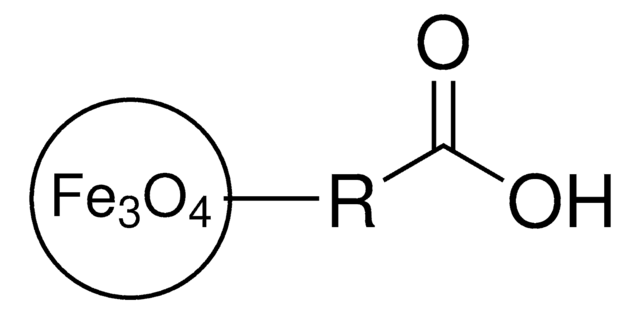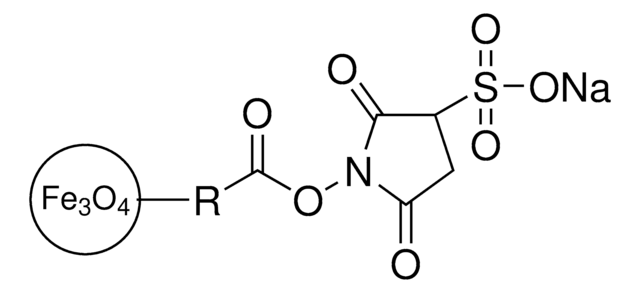747408
Iron oxide(II,III), magnetic nanoparticles solution
30 nm avg. part. size (TEM), PEG functionalized, 1 mg/mL Fe in H2O, dispersion
Synonyme(s) :
Fe NP PEG, FexOy, Magnetic iron oxide nanocrystals, Magnetite, Superparamagnetic iron oxide nanoparticles
About This Item
Produits recommandés
Forme
dispersion
nanoparticles
Niveau de qualité
Concentration
1 mg/mL Fe in H2O
Magnétisation
>45 emu/g (at room temperature; under 4500 Oe)
Couleur
black
Taille moy. des particules
30 nm (TEM)
Densité
0.988 g/mL at 25 °C
~1 g/mL at 25 °C
Groupe fonctionnel
PEG
Température de stockage
2-8°C
Chaîne SMILES
O=[Fe].O=[Fe]O[Fe]=O
InChI
1S/3Fe.4O
Clé InChI
SZVJSHCCFOBDDC-UHFFFAOYSA-N
Vous recherchez des produits similaires ? Visite Guide de comparaison des produits
Description générale
Application
Do not freeze.
Informations légales
Code de la classe de stockage
12 - Non Combustible Liquids
Classe de danger pour l'eau (WGK)
WGK 2
Point d'éclair (°F)
Not applicable
Point d'éclair (°C)
Not applicable
Faites votre choix parmi les versions les plus récentes :
Déjà en possession de ce produit ?
Retrouvez la documentation relative aux produits que vous avez récemment achetés dans la Bibliothèque de documents.
Les clients ont également consulté
Articles
The recent emergence of a number of highly functional nanomaterials has enabled new approaches to the understanding, diagnosis, and treatment of cancer.
Professor Yadong Yin (University of California Riverside, USA) examines both direct (thermal decomposition, solvothermal, hydrothermal) and indirect (templated) synthesis methods of magnetite nanocrystals and reviews in detail the landscape of these various synthetic methods for magnetite nanocrystal and their applications in magnetic assembly, magnetic hyperthermia, and Li-Ion batteries.
Biomaterials science involves the design and fabrication of smart materials for studying, directing, or mimicking biology. For successful integration of biomaterials in biological research, a meaningful understanding of biological systems is required.
Notre équipe de scientifiques dispose d'une expérience dans tous les secteurs de la recherche, notamment en sciences de la vie, science des matériaux, synthèse chimique, chromatographie, analyse et dans de nombreux autres domaines..
Contacter notre Service technique

